Holy Sengol in New Parliament Building: A Challenge to Congress’s Secular Ecosystem
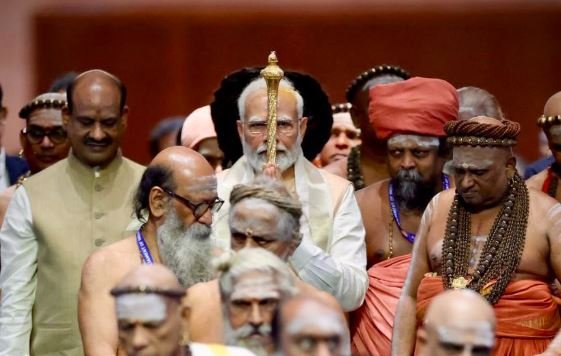

The news of the installation of the holy Sengol in the new Parliament building inaugurated by Prime Minister Narendra Modi on May 28, 2023 sparked a sudden surge in interest in the scepter. Searches for the keyword “Sengol” rose sharply, with people eager to learn more about this mysterious & unheard object.
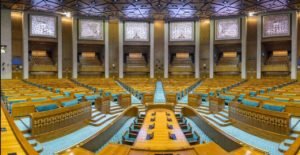
The Sengol is a sceptre that was used by the Chola kings of India. It is a symbol of justice, good governance, and the transfer of power.
In Tamil, the word “sengol” means “righteousness.” It is derived from the words “semmai,” which means “righteousness,” and “kol,” which means “stick.” When a new ruler was appointed, they would be given the order (aanai in Tamil) to rule with dharma, which means to rule justly and fairly.
The Sengol was used by the Chola kings to symbolize their authority and their commitment to justice. The sceptre was carried before the king when he went to court, and it was used to administer justice. The Sengol was also used to bless new temples and to mark important religious festivals.

The Sengol was passed down from king to king for over 500 years. The sceptre was used by the Chola kings to build a powerful empire that stretched from the Himalayas to the southern tip of India. The Chola kings were known for their great military prowess, their architectural achievements, and their patronage of the arts.
The Sengol was first used by the Chola king Karikala Chola I (reigned 907-955 CE). Karikala was a great warrior and administrator, and he used the Sengol to symbolize his commitment to justice and good government. The Sengol was passed down from king to king, and it became a symbol of the Chola Empire’s power and prestige.
The Sengol was lost to history in the 16th century CE. The sceptre was most likely destroyed during the invasion of India by the Mughal invaders. However, the Sengol’s legacy lives on. The sceptre is a symbol of India’s rich history and culture, and it is a reminder of the country’s commitment to justice and good governance.
The unexpected rediscovery of the Sengol, the 5 feet long sceptre, crafted from gold and silver topped with a golden orb carved with an image of Nandi, Sacred to Shiva and symbol of Nyaya, or Justice has caused quite a stir among the opposition.
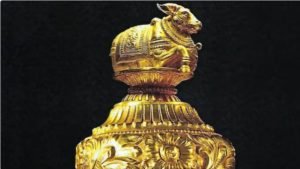
Symbolizing the sacredness and cultural legitimacy of the momentous occasion on August 14, 1947, the sceptre was presented to India’s Prime Minister designate by the departing British, Nicholas Mountbatten, and the last Viceroy of British India handed the sceptre over to the Tamil Saints who purified it. The Saints then handed the sceptre over to Prime Minister designate, Jawaharlal Nehru at his home just before he left for Parliament House to deliver the historic ‘tryst with destiny’ speech. When Jawaharlal Nehru sought guidance from C. Rajagopalachari on how to bestow traditional legitimacy upon the transfer of power from the British, he was directed towards the ancient Chola tradition. This custom involved the Raja Guru presenting a sceptre to the newly crowned king during his coronation. To bring this historical practice to life, a renowned Jeweller from Madras, Vummudi Bangaru Chetty, was entrusted with the task of crafting the exquisite ‘Sengol’ within a span of four weeks with the guidance of Adheenams (priests) from Shaivite mutts in Tamil Nadu. Shri Vummidi Ethirajulu and his younger brother Vummidi Sudhakar of Vummudi Bangaru Chetty Jewellerry designed and crafted the Sengol, the historical artefact of India.
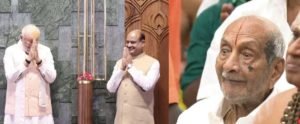
Since then, the ‘Sengol’ has become an indelible part of India’s journey towards independence. It stands as a powerful symbol, deeply rooted in the nation’s vibrant history and rich culture. More importantly, it serves as a constant reminder of India’s unwavering commitment to justice and effective governance. The presence of the ‘Sengol’ signifies the country’s dedication to upholding these values as it forges ahead on its path of progress. But, the holy Sengol which was rediscovered in 1947 to showcase India’s rich history and culture, just as India was about to gain independence from the British Empire was relegated and demeaned to being labelled a “walking stick gifted to Jawahar Lal Nehru” and kept in a dusty corner of a museum in Allahabad. It makes sense seeing how anti Hindu Jawahar Lal Nehru and his legacy were for Bharat Varsha.
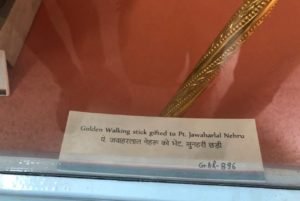
The Sengol’s sudden reappearance, after being hidden away for so long years, poses a threat to the very foundation of the hollow form of “secularism” that the opposition has carefully nurtured over the years. The renewed attention on the Sengol calls into question the significance of the soulless approach to governance that the opposition has championed, and raises doubts about its ability to honour the cultural and religious aspects of India’s history and heritage. The Congress led opposition’s reaction to the Sengol’s rediscovery is a clear sign that they are deeply uncomfortable with the country’s rich cultural heritage. They would prefer to see India as a so-called secular nation with no religious or cultural identity. However, the Sengol is a reminder that India is a country with a deep and complex history, and that its culture is an important part of its identity. The rediscovery of the Sengol is a positive development for India. It is a reminder of the country’s rich cultural heritage, and it is a challenge to the opposition’s hollow form of secularism and its eco-system. The Sengol is a symbol of India’s unity, and it is a reminder that the country’s cultural heritage is an important part of its identity.

The ‘Sengol’, which didn’t find a place of honour by the Congress and its legacy now, will be the symbol of India’s spiritual traditions and their role in governance. The Sengol, which represents Bharat Varsha’s traditions and vast cultural heritage, has been installed in the new Parliament building by performing Vedic rituals, which was inaugurated by Prime Minister Narendra Modi on May 28, 2023 on the birth anniversary of Veer Damodar Savarkar with the presence of dignitaries and mutt heads, including Thiruvavaduthurai Adheenam’ Sri La Sri Ambalavana Desika Paramacharya Swamigal.
The Sengol will be a reminder of India’s past, present and future by symbolising new India’s commitment to justice and good governance.
DISCLAIMER: The author is solely responsible for the views expressed in this article. The author carries the responsibility for citing and/or licensing of images utilized within the text.
